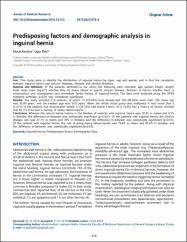Predisposing factors and demographic analysis in inguinal hernia
Özet
Aim: This study aims to identify the distribution of inguinal hernia by types, age and gender, and to find the correlation
between inguinal hernia and chronic diseases, lifestyle and familial tendency.
Material and Methods: Of the patients admitted to our clinic, the following were recorded: age, gender, height, weight,
body mass index (kg/m²), whether they do heavy labour or sports, chronic disease, direction of hernia, whether there is
incarceration and strangulation and immediate family history of inguinal hernia. The data were analysed using the SPSS
statistics software. p<0.05 was considered significant.
Results: The study included 116 patients, of whom 12 (10.34%) were female and 104 (89.66%) were male. The mean age
was 52.89 years, and the median age was 53.5 years. When the whole study group was evaluated, it was found that 5
(4.31%) of the patients had incarceration where 31 (26.72%) had family history, 36 (31.03%) had a history of chronic disease
and 85 (73.27%) had a history of heavy labour/sports.
Conclusion: Whereas the rate of hernia history in the families of patients with inguinal hernia was 28.8% in males and 8.3%
in females, the difference in-between was statistically significant (p<0.001). Of the patients with inguinal hernia, the chronic
disease rate was 31.7% in males and 25% in females, and the difference in-between was statistically significant (p<0.01).
Of the patients with inguinal hernia, the rate of doing heavy labour/sports was 78.6% in males and 41.6% in females, and
the difference in-between was statistically significant (p<0.01).
Cilt
26Sayı
4Bağlantı
https://hdl.handle.net/11363/6382Koleksiyonlar
Aşağıdaki lisans dosyası bu öğe ile ilişkilidir:


















